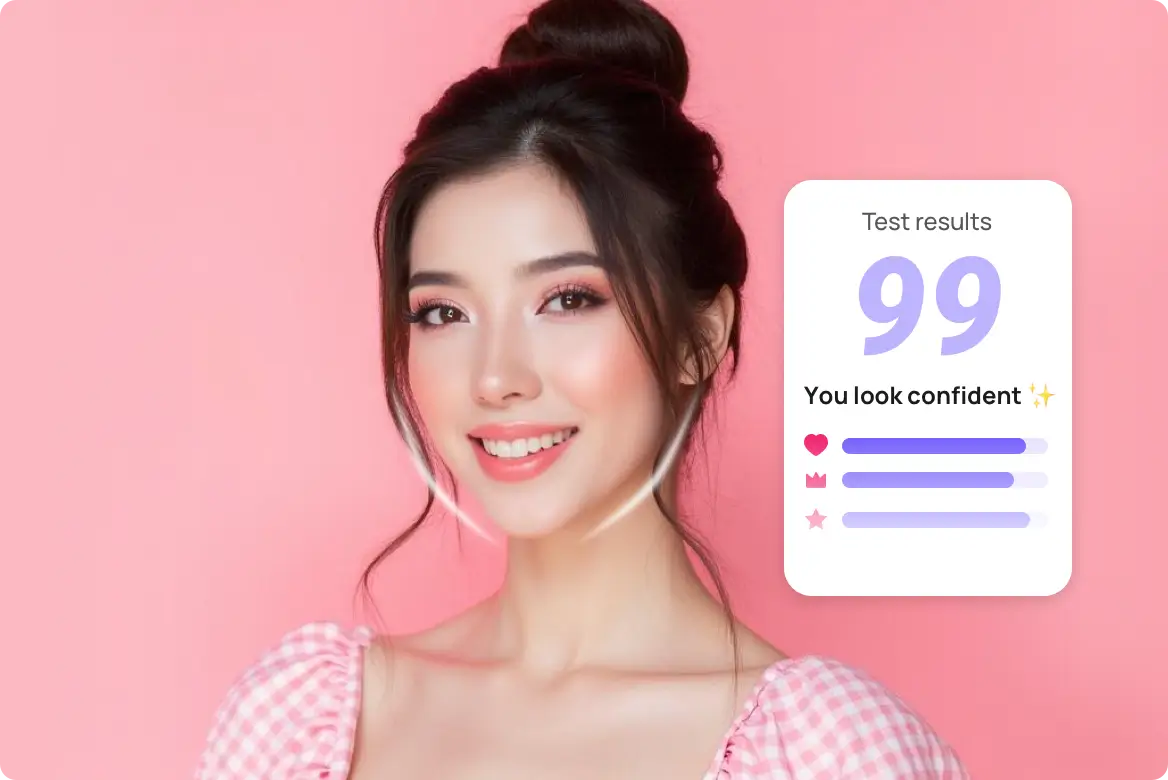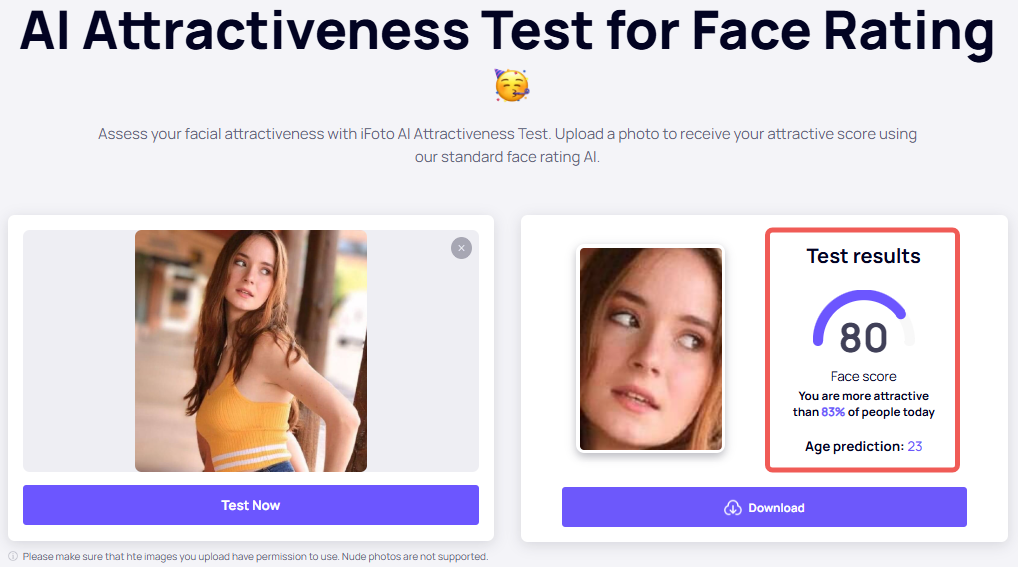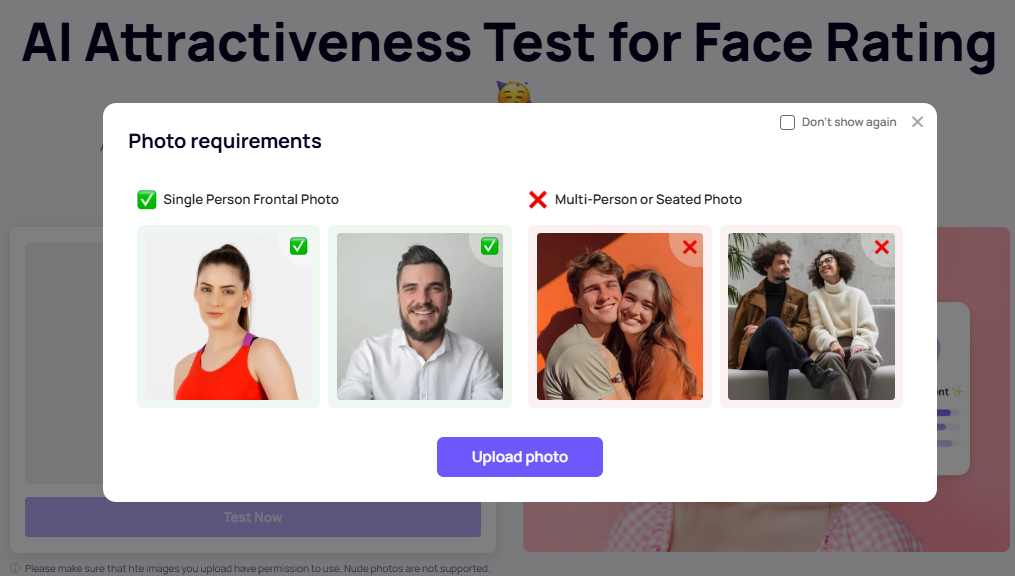AI Attractiveness Test: Discover Your Beauty Score Today!
Have you ever pondered the enigmatic complexities of your own visage, the subtle nuances that coalesce to form your perceived attractiveness? The rise of Artificial Intelligence has brought forth a fascinating, if somewhat controversial, new frontier: the automated assessment of facial appeal.
This technology, often packaged as "AI attractiveness tests," promises to decode the secrets of beauty, providing users with a numerical score and insights into their facial characteristics. But is this objective assessment, powered by algorithms and vast datasets, a valid reflection of beauty? Or is it merely a technological echo of subjective human perception?
Before we delve deeper, let's briefly define what we mean by "face analysis attractiveness." It refers to the systematic evaluation of facial features to determine levels of aesthetic appeal. This assessment can be performed through various methods, including manual analysis, software algorithms, and, of course, artificial intelligence.
- X20shelby Stanga Accident What Happened To The Ax Men Star
- Latest On Ullu Filmywap More Download Watch Now
Now, let's consider the mechanics of these AI-driven tests. The core principle is relatively straightforward: a user uploads a photograph, and an AI algorithm analyzes the image, scrutinizing various facial features. These features typically include:
- Facial Symmetry: The degree to which the two halves of the face mirror each other. Symmetry is often considered a marker of health and genetic fitness, which can contribute to perceived attractiveness.
- Facial Proportions: The ratios between different facial features, such as the distance between the eyes, the width of the nose, and the size of the lips. Ideal proportions are often associated with classical beauty standards.
- Skin Texture: The smoothness and clarity of the skin, often free from blemishes or wrinkles, which can significantly influence the overall perception of attractiveness.
- Specific Features: Analysis of the shape of the eyes, the fullness of the lips, the shape of the jawline and the brow shape.
The AI then cross-references these measurements against a pre-programmed database of aesthetic criteria and normative data, often derived from research on human preferences and established beauty standards. This comparative analysis results in a "beauty score," frequently presented on a scale (such as 1 to 10), along with some explanatory insights.
The popularity of these tests is undeniable. Platforms such as "ifoto ai attractiveness test" and "vidwud ai attractiveness test" offer users a quick and easy way to get their faces rated. Other websites offer similar services, and the tests are often promoted as fun, interactive tools that can offer a quick assessment of facial appeal.
- P Diddys Birth Chart Insights Astrological Analysis
- Ella Clooney Before Fame Family Facts You Didnt Know
These tools often highlight the advantages of their services, such as:
- Speed and Convenience: The ability to receive an instant assessment by simply uploading a photo.
- Objectivity: The claim that the AI provides an unbiased evaluation based on data, rather than subjective human opinions.
- Insight: The potential to learn more about one's facial characteristics and how they may be perceived by others.
Let's explore some real-world examples to better understand the landscape of AI attractiveness tests:
- Ifoto AI Attractiveness Test: This platform offers a simple and user-friendly interface. Users upload a photo and receive an attractiveness score. The primary function is to generate an attractiveness score for the uploaded photo.
- Vidwud AI Attractiveness Test: This tool shows how attractive you are.
But what about the reliability and validity of these AI assessments? This is where the conversation gets complicated. While AI algorithms are impressive in their ability to analyze data, the concept of "objective beauty" is, itself, a complex and contested notion. Several factors influence attractiveness beyond what an algorithm can easily quantify.
Here are some of the key considerations that cast a shadow on the reliability of AI attractiveness tests:
- The Subjectivity of Beauty Standards: Beauty standards are not static. They evolve over time and vary significantly across cultures, ethnicities, and even individual preferences. Algorithms trained on datasets reflecting specific beauty ideals might not accurately reflect the diverse and nuanced beauty preferences that exist in the real world.
- The Limitations of Facial Analysis: Facial analysis tools are, at their core, limited to analyzing facial features. Factors such as body language, personality, style, charisma, and social context play a significant role in perceived attractiveness. AI tools simply do not consider these complex aspects.
- Data Bias: AI algorithms are only as good as the data they are trained on. If the data used to train the algorithm contains biases (e.g., an overrepresentation of a certain ethnicity or age group), the resulting assessments will likely reflect those biases.
- Technical Issues: The accuracy of the analysis depends on the quality of the photo. Factors such as lighting, pose, and photo resolution can significantly impact the results.
Furthermore, the emphasis on a numerical score can contribute to feelings of self-consciousness or inadequacy. The very act of assigning a number to one's attractiveness can encourage people to place undue importance on superficial aspects of their appearance. It's worth remembering that there is more to a person than a score.
Many individuals are curious about how they measure up against beauty standards, and AI attractiveness tests offer a seemingly convenient way to satisfy this curiosity. The ease of use, the speed of the analysis, and the promise of objectivity are all attractive features. However, it is essential to approach these tests with a healthy dose of skepticism.
Here's a step-by-step guide on how to use an AI attractiveness test (using a general example):
- Choose a Platform: Select a platform offering an AI attractiveness test (e.g., "ifoto ai attractiveness test").
- Upload a Photo: Follow the platform's instructions to upload a clear, well-lit photo of your face. Ensure your face is fully visible and that your pose is neutral.
- Await Analysis: Wait for the AI to process your photo and analyze your facial features. This may take a few seconds.
- Review Results: Examine the results, including the attractiveness score and any insights provided by the AI.
- Interpret with Caution: Remember that these results are just one data point and shouldn't be the sole basis for your self-perception.
Consider this as an exercise in self-exploration but do not allow the results to significantly influence your self-worth or decisions.
Let's delve deeper into the process of evaluating your facial attractiveness. When using these tests, the system will evaluate different elements.
- Symmetry: The degree to which the left and right sides of your face mirror each other is assessed. High facial symmetry is frequently linked with attractiveness, perhaps because it's a visual sign of health.
- Proportions: The ratios between different facial characteristics, such as the distance between your eyes, the width of your nose, and the size of your lips, are assessed. There are proportions that are often considered ideal.
- Skin Texture: The state of your skin is taken into account. The algorithm examines smoothness and lack of blemishes.
- Specific Features: Shape of your eyes, lips, the structure of your jawline and the shape of the brows
By analyzing the image, the technology provides a beauty score.
Here is an example table that illustrates how these technologies are used:
| Feature | Description | How AI Analyzes |
|---|---|---|
| Facial Symmetry | The degree to which the left and right sides of the face mirror each other. | Algorithms measure the distance between corresponding facial features on both sides and calculate the level of symmetry. |
| Facial Proportions | The ratios between different facial features, such as the distance between the eyes and the width of the mouth. | AI compares these ratios to established ideals, often based on the Golden Ratio or other aesthetic standards. |
| Skin Texture | The smoothness and clarity of the skin, often free from blemishes or wrinkles. | AI analyzes the skin's surface to identify irregularities and assess overall texture. |
| Feature Analysis | Assessment of the shape and size of specific features like eyes, lips, nose, and eyebrows. | AI uses shape detection to identify specific features and compare them to datasets of ideal feature characteristics. |
The AI attractiveness test by ifoto is a fun and interactive tool that allows users to assess their facial attractiveness based on current beauty standards. Whether you're curious or seeking a confidence boost, take the test now to reveal your true beauty potential!
Here are some important considerations:
- Skepticism: Approach the results with a healthy dose of skepticism.
- Diverse Beauty: Recognize that beauty standards vary and that an AI score doesn't encompass the full spectrum of human attractiveness.
- More Than Looks: Remember that factors like personality, kindness, and intellect contribute significantly to how others perceive your overall appeal.
Ifoto AI Attractiveness Test vs. Human Perception
These tests offer a unique perspective, but how do they measure up against human assessment? They can be a fun way to explore how your features align with todays beauty ideals. In many ways, such tests are a technological echo of how humans have always gauged appeal, based on visual cues. However, the human eye is far more complex, factoring in things that algorithms miss, like:
- Emotion: A warm smile or a genuine expression can significantly enhance a person's perceived attractiveness.
- Context: How someone looks and how they behave in a given situation, which significantly impacts perceptions of attractiveness.
- Personality: The way people present themselves, which can change over time
In essence, AI attractiveness tests are a tool and can be a fun and convenient way to gain a sense of how your facial features might be perceived in the context of standardized beauty metrics. They are most useful when used in tandem with a broader perspective. They are not a substitute for self-acceptance, genuine interactions, or the ability to see beauty beyond the surface.
AI tools have become a significant part of the digital landscape. They're in our phones, our cars, and even evaluating our faces.
Here's a comparative overview of some popular AI attractiveness test platforms.
| Platform | Key Features | Strengths | Limitations |
|---|---|---|---|
| ifoto AI Attractiveness Test | Simple user interface, photo upload, attractiveness scoring. | Ease of use, quick results. | Limited features, potential bias in scoring. |
| Other Platforms | Varying features including scoring, age estimation, and additional facial analysis. | Potentially more detailed analysis. | Varying levels of accuracy, potential bias in algorithms. |
The ai attractiveness test by ifoto is a fun and interactive tool that allows users to assess their facial attractiveness based on current beauty standards. This tool provides a quick and concise evaluation. Remember these AI attractiveness tests provide a snapshot, not a definitive verdict.
- Antony Starr The Boys Star His Sexuality Everything You Need To Know
- Unveiling Spencer Oreilly Age Net Worth Family Secrets

Free Attractiveness Test Online for AI Face Rating iFoto

How Attractive Am I? Find Your Beauty with the iFoto AI Attractiveness

How Attractive Am I? Find Your Beauty with the iFoto AI Attractiveness